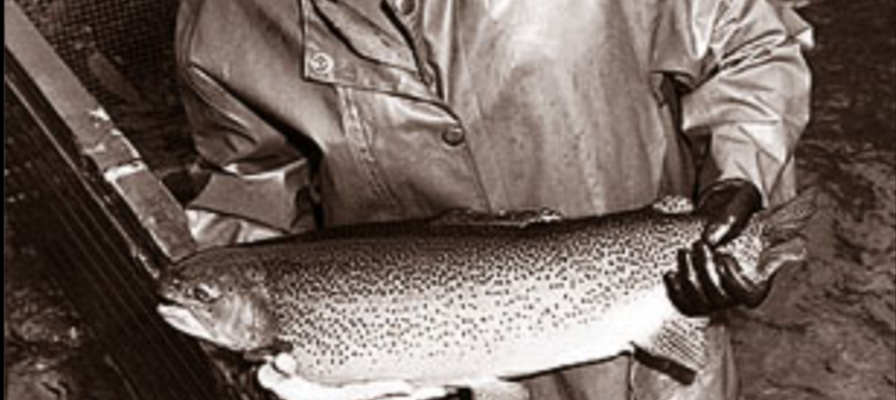As February slid into March and April the biologists eased into the rhythm of maintaining and measuring their research populations. Ennui set in. The lab notebook read “routine care of fish” or “routine care of test animals.”58 These lackadaisical accounts masked important developments. On 13 March, the last of the A-lot fry that had been irradiated to 10,000 r had died.59 The last of those irradiated to 5000 r died two days later and the 2500 r lots only survived six days past that.60 Their short lives from the end of January to the middle of March fulfilled Warren’s desire for fish treated to the point of significant somatic insult. Welander reported that as death neared, “the fish in these groups were very weak, almost unable to swim, the heart beat in each was slow and spasmodic, and many seemed unable to… move the lower jaw normally in respiration.”61 These highly irradiated fish also appeared wan, with a “comparative lack of pigment… as compared to control fish.”62 Though the highly irradiated fish died, the A-lot chinook irradiated to up 1000 r survived and Welander’s study continued. While he furiously worked to take data on dying chinook, Welander and Foster worked on honing their photographic technique. Just a day before the last of the 10,000 r A-lot individuals died, “Dr. Bonham took pictures of kidney tissues and experimented on best method of taking photomicrographs of tissue. Labeled slides.”63 The lab’s researches came to the point at which they found as much value in the dead as in the living. Though the team spent significant time in the Spring working on laboratory technique, they also began preparing for a new deadline that would move their research from the lab into the wild. Lots 1 – 34 had grown by leaps and bounds. Now five months old, they overtaxed their tank space even after the constant picking off of dead individuals and subjects for histology. On 20 March, the team started reducing other lots of offspring from the original October chinook down to 1000 individuals. They took “surplus fish” to Issaquah Creek, east of Seattle, to be released. Hundreds of chinooks whose parents had been irradiated entered the local biome.64 Donaldson made no mention of any concern that the fish might harm local, wild populations. By freeing laboratory irradiated fish in a wild creek, the team displayed their tacit understanding that local environments could absorb the effects of radiation. Treated fish could mate with wild fish, Donaldson did not bat an eye. As the bulk of the offspring from the October chinook found freedom in the foothills of the Cascades, tanks nine and 10 suffered no attrition. These offspring of two 100 r parents or two 0 r parents, representing the ends of the exposure spectrum, received “more room to grow and develop. They are to be held for later marking experiments.”65 Donaldson had decided that he would release these two groups into the wild to mature and hopefully return as adults ready to spawn. The lab’s research approached a critical juncture, when treated fish would leave the confines of inside troughs and tanks and even of outside ponds in order to travel down a freshwater river and out into the salty Puget Sound and the vast expanses of the north Pacific. “The chinook salmon,” Donaldson would write of these fingerlings, “must migrate to the sea or it will die.”66 The lab had to let go of its fish, if they were to create the kind of useful data that could anticipate the effects of fission on populations of wild salmon that naturally migrated from the Columbia to the open ocean. Bishop and Warren visited the lab as the team prepared to set loose their first chinook into the wild. Bishop came first, on 20 April. “The day was spent in conference with him on normal and abnormal histology of fishs [sic].”67 The team started off the day by taking tissue samples, a blood count, and a hemoglobin percentage measure from one of Bonham’s rainbow trout. Then they picked one of the original chinook fingerlings each from tanks one through 10 for histological practice. With Bishop on hand, Bonham measured them and then made a series of cuts, taking seven sections from each fish. His lab technique shone for the visitor from Rochester. Warren arrived for a conference the following day, during which time “Mr. Tomlin took some pictures of the personel [sic] and Dr. Warren and Dr. Bishop.”68 The team knew Tomlin well as he was the local Corps of Engineers photographer and had visited the lab to take pictures of fish on a number of occasions. The mood in these pictures appears jovial, upbeat. I suspect that by this point Donaldson, Foster, Bonham, and Welander became aware, in some way, of their participation in the atomic project.69 Certainly, after this all-hands meeting there would never be an instance of confusion and cross purposes as there had been the previous December. On the contrary, these days together indicated the beginning of a close and long relationship between Warren and Donaldson, in which the former acted as patron and the latter industrious disciple.
Lire la suite ici :
https://escholarship.org/content/qt5ss7h51f/qt5ss7h51f_noSplash_fd4a7d864b790cabac2fa3599ae0878d.pdf
Ainsi que les expériences dans le pacifique.
